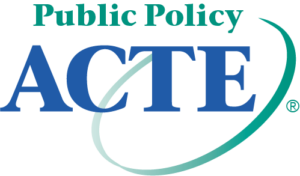
Getting Started: Social media advocacy is one of the quickest and simplest ways to spread positive and effective information about CTE to your Members of Congress, your communities and the media. The possibilities for sharing on social media are endless – for example, you can share about the benefits of your CTE program, activities your students are involved in, course offerings or your thoughts on key policy issues.
If you are already active on major social media platforms, e.g., Facebook, Twitter, and Instagram, you are all set up for this week’s advocacy task.
TAKE ACTION: Draft at least one social media post to share with your federal policymakers expressing the importance of investing in CTE to:
- Upskill and reskill workers to respond to the ever-changing demands of a pandemic-impacted economy.
- Include specific examples about how you are equipping your students to succeed.
- Help institutions recover from the financial demands of the pandemic and build on innovations that emerged during the last year.
- Discuss challenges you have faced and innovations you have made. As educators and administrators, you know your program best!
- Develop the educators, program content and flexibility necessary to help meet future workforce needs.
- Explain how you are meeting workforce needs in your program!
Tag your Members of Congress and ACTE’s social media account for that platform in your posts!
- Many Members of Congress have official Twitter, Facebook and Instagram accounts. Typically, you will just need to search for your Member’s name on your desired social media platform, and their associated accounts will pop up. Including “Senator” or “Representative/Congressman” in your search may bring you faster results.
- An updated list of Twitter accounts for the 117th Congress can be found here.
- Try to tag their official government accounts, instead of their campaign or personal accounts. They will often have a note in their bio to signal whether it is their official account or a personal one.
- Keep your posts light on text – keep them short and sweet for the best chance of a policymaker or their staff taking notice or interacting with a post.
- Abbreviations can be used on Twitter to save characters, but Facebook and Instagram do not have a character limit, and you should avoid abbreviating anything that could be unclear.
- Identify yourself as a constituent, either through a note in your bio, adding a geolocation to your post or mentioning where you reside in your post.
- To increase the potential of interaction, include a question, e.g., What will you do to support CTE students and educators in [your area]?
Social Media Basics:
- Keep it positive: Straying away from your core message will cause the community to lose trust in you and diminish the attention your social media presence receives from your followers, policymakers and media.
- Engage with others: Conversation is a two-way street, even online. Join topics and discussions with other people and organizations. The more you engage the CTE community and policymakers, the more the CTE message moves forward.
- Be personal: Share your story of CTE through your own voice instead of “broadcasting” the message. Let your messages reflect your personality, use humor, and be transparent about who is posting messages.
- Use photos and graphics: In a visual age, graphics and other images can help you draw attention to your posts and illustrate your messages. Make sure to use relevant graphics, photos and GIFs to help add more context and personality to your posts. Make sure to get permission and follow local policies about sharing images of your students though!
Make sure to follow ACTE’s profiles on Facebook, Twitter, and Instagram; ACTE’s Public Policy Department also maintains @ACTEpolicy, an account on Twitter to follow the latest news and updates in the CTE policy sphere. This account is where we will be promoting your advocacy efforts!
If you do not have social media accounts and would like to create them, follow these links for step-by-step instructions on how to create accounts for each major social media platform.
- Alternatively, if you are not active on social media and do not wish to be, you can draft and publish a blog post on your personal or institution’s blog, which the Public Policy Department will then share on social media and on ACTE’s Medium page. If you do not have access to a blog, send the text of your post to Jori Houck, jhouck@acteonline.org, for publication. Potential blog subjects include how you develop effective CTE programs, the impact of CTE on your school, community, or region, or how CTE has made a difference in your life or your students’ lives – the list continues!
More tips, tools and ideas for social media and blogs can be found in the Advocacy Resources section of ACTE’s website. If you have questions, comments or concerns, please contact Jori Houck, ACTE Media Relations and Advocacy Associate, at jhouck@acteonline.org.
